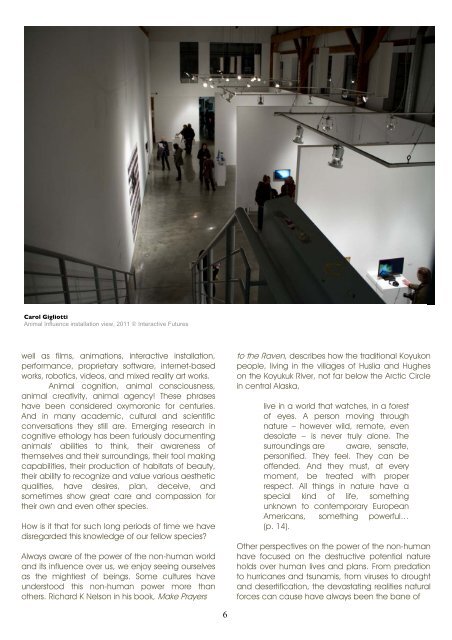Animal Influence I - Antennae The Journal of Nature in Visual Culture
Animal Influence I - Antennae The Journal of Nature in Visual Culture
Animal Influence I - Antennae The Journal of Nature in Visual Culture
You also want an ePaper? Increase the reach of your titles
YUMPU automatically turns print PDFs into web optimized ePapers that Google loves.
Carol Gigliotti<br />
<strong>Animal</strong> <strong>Influence</strong> <strong>in</strong>stallation view, 2011 Interactive Futures<br />
well as films, animations, <strong>in</strong>teractive <strong>in</strong>stallation,<br />
performance, proprietary s<strong>of</strong>tware, <strong>in</strong>ternet-based<br />
works, robotics, videos, and mixed reality art works.<br />
<strong>Animal</strong> cognition, animal consciousness,<br />
animal creativity, animal agency! <strong>The</strong>se phrases<br />
have been considered oxymoronic for centuries.<br />
And <strong>in</strong> many academic, cultural and scientific<br />
conversations they still are. Emerg<strong>in</strong>g research <strong>in</strong><br />
cognitive ethology has been furiously document<strong>in</strong>g<br />
animals’ abilities to th<strong>in</strong>k, their awareness <strong>of</strong><br />
themselves and their surround<strong>in</strong>gs, their tool mak<strong>in</strong>g<br />
capabilities, their production <strong>of</strong> habitats <strong>of</strong> beauty,<br />
their ability to recognize and value various aesthetic<br />
qualities, have desires, plan, deceive, and<br />
sometimes show great care and compassion for<br />
their own and even other species.<br />
How is it that for such long periods <strong>of</strong> time we have<br />
disregarded this knowledge <strong>of</strong> our fellow species?<br />
Always aware <strong>of</strong> the power <strong>of</strong> the non-human world<br />
and its <strong>in</strong>fluence over us, we enjoy see<strong>in</strong>g ourselves<br />
as the mightiest <strong>of</strong> be<strong>in</strong>gs. Some cultures have<br />
understood this non-human power more than<br />
others. Richard K Nelson <strong>in</strong> his book, Make Prayers<br />
6<br />
to the Raven, describes how the traditional Koyukon<br />
people, liv<strong>in</strong>g <strong>in</strong> the villages <strong>of</strong> Huslia and Hughes<br />
on the Koyukuk River, not far below the Arctic Circle<br />
<strong>in</strong> central Alaska,<br />
live <strong>in</strong> a world that watches, <strong>in</strong> a forest<br />
<strong>of</strong> eyes. A person mov<strong>in</strong>g through<br />
nature – however wild, remote, even<br />
desolate – is never truly alone. <strong>The</strong><br />
surround<strong>in</strong>gs are aware, sensate,<br />
personified. <strong>The</strong>y feel. <strong>The</strong>y can be<br />
<strong>of</strong>fended. And they must, at every<br />
moment, be treated with proper<br />
respect. All th<strong>in</strong>gs <strong>in</strong> nature have a<br />
special k<strong>in</strong>d <strong>of</strong> life, someth<strong>in</strong>g<br />
unknown to contemporary European<br />
Americans, someth<strong>in</strong>g powerful…<br />
(p. 14).<br />
Other perspectives on the power <strong>of</strong> the non-human<br />
have focused on the destructive potential nature<br />
holds over human lives and plans. From predation<br />
to hurricanes and tsunamis, from viruses to drought<br />
and desertification, the devastat<strong>in</strong>g realities natural<br />
forces can cause have always been the bane <strong>of</strong>












